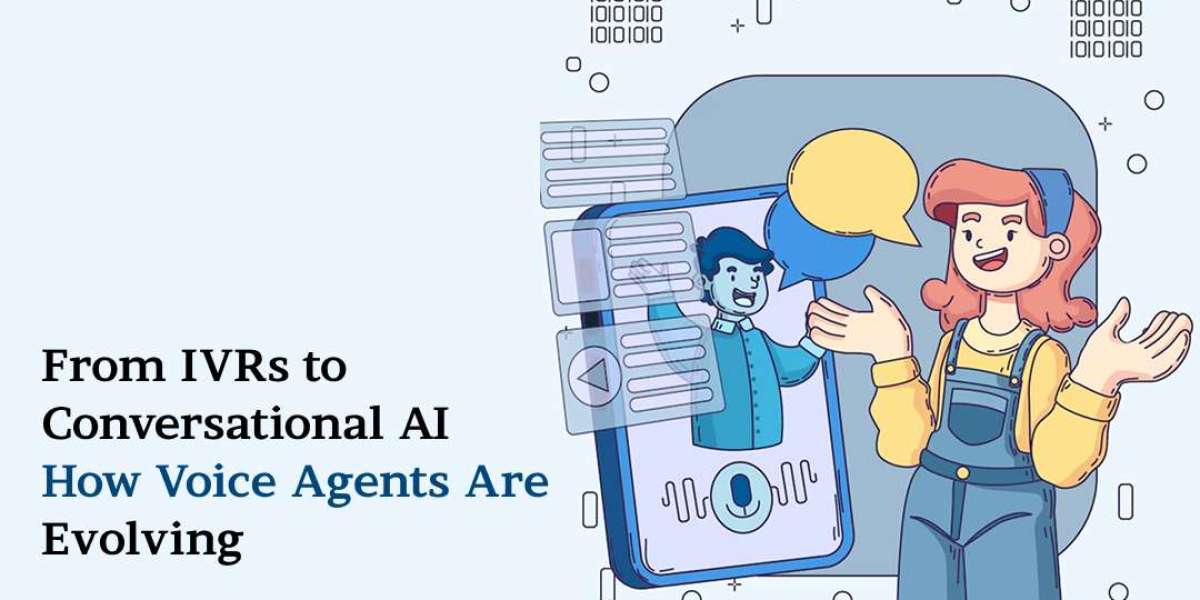Once upon a time, we all suffered through it—“Press 1 for Sales, Press 2 for Support.” IVR (Interactive Voice Response) systems were the default solution for call routing. They were better than nothing, but just barely. Stiff, linear, and often frustrating, IVRs could never truly understand human intent.
Today, voice agents have evolved dramatically, thanks to AI development. We’ve moved beyond menu trees and into the era of Conversational AI—smart, responsive systems that understand natural language, remember context, and deliver real human-like interactions.
This blog will walk you through that evolution—from the robotic IVRs of the past to the sophisticated AI voice agents of today. We’ll also explore what this transformation means for businesses and why investing in modern voice agents might be one of the smartest customer experience decisions you’ll make.
IVRs: The Clunky Beginnings of Voice Automation
Let’s rewind a few decades. IVR systems were revolutionary when they first arrived. For the first time, companies could automate simple call routing without a human agent.
But here’s the truth: IVRs were never built for conversation. They were designed for efficiency, not empathy. And as customer expectations evolved, the limitations of IVRs became painfully clear:
- Poor speech recognition
- Rigid decision trees
- No memory of prior context
- High drop-off rates due to frustration
In short, IVRs treated people like machines. The result? People started pressing “0” just to speak to a real person.
The Rise of Natural Language Processing in Voice Tech
So, what changed?
The answer lies in AI development, specifically in Natural Language Processing (NLP). NLP enabled systems to go beyond keyword spotting and actually understand what a human was saying.
By 2015, major strides in speech-to-text, language modeling, and intent recognition made it possible to move from IVRs to intelligent voice assistants.
For example, instead of saying:
“Press 3 for technical support.”
You could simply say:
“I’m having trouble connecting my internet,”
—and the system would understand.
This shift from command-based input to natural language interaction marked the beginning of conversational AI.
What Exactly Is Conversational AI?
Conversational AI is more than just a chatbot with a voice. It’s a dynamic system that leverages multiple branches of AI development to simulate real human dialogue. Here's what it typically includes:
- Speech recognition: Converting spoken words into text
- Natural Language Understanding (NLU): Understanding meaning and intent
- Dialogue management: Maintaining coherent multi-turn conversations
- Contextual memory: Recalling previous interactions
- Text-to-speech: Responding in human-like speech
With these capabilities, conversational AI voice agents can handle everything from answering product queries to processing payments—and do it all in a way that feels genuinely human.
Why the Shift to AI Voice Agents Is Accelerating in 2025
There are five key reasons why the adoption of conversational AI is skyrocketing:
1. Customer Expectations Are Higher Than Ever
In the age of WhatsApp, Alexa, and Siri, customers expect instant, natural, and context-aware support. IVRs just can’t keep up. Modern voice agents, powered by AI development, offer faster and more personalized service.
2. Cost Efficiency at Scale
Hiring and training human agents is expensive. AI voice agents provide 24/7 support at a fraction of the cost. They also scale infinitely, handling thousands of conversations simultaneously.
3. Multilingual and Omnichannel Support
AI voice agents can speak multiple languages and switch seamlessly between voice, text, and even video support—thanks again to advancements in AI development.
4. Integration with CRMs and Business Tools
Voice agents can now pull data from your CRM, payment systems, or ticketing software in real time. This leads to smarter conversations—like knowing a customer’s recent purchase or past complaint without needing to ask.
5. Measurable ROI
Businesses implementing AI voice agents often see major improvements in metrics like:
- First-call resolution rates
- Average handle time
- Customer satisfaction scores (CSAT)
- Agent workload reduction
According to a Gartner report, companies using conversational AI see a 25% reduction in operational costs within the first year.
The “Telecom Turnaround” Case
In 2023, we worked with a mid-sized Indian telecom company struggling with IVR abandonment rates over 60%. Customers were either pressing “0” immediately or hanging up.
We replaced their IVR with a conversational AI voice agent trained on telecom-specific intents. Within 3 months:
- Call containment improved by 44%
- Average call duration reduced by 36%
- CSAT scores increased from 3.2 to 4.4
This is the kind of shift AI development makes possible when done right.
How AI Voice Agents Work
Let’s make it simple.
The Analogy:
Think of a traditional IVR as a vending machine. You press buttons, and it gives you what you selected—no more, no less.
Now, imagine talking to a helpful store assistant who understands what you’re looking for, suggests the best option, and remembers your preferences from last time. That’s conversational AI.
The Technical View:
AI voice agents work by combining:
- ASR (Automatic Speech Recognition) to hear you
- NLU to understand your intent
- Dialog flow engines to keep the conversation going
- TTS (Text-to-Speech) to respond naturally
- Memory to personalize future interactions
And all of this happens in milliseconds.
The Hard Truth: AI Voice Agents Aren’t Magic
Let me be brutally honest—AI voice agents aren’t a magic fix. If you rush the development, use bad training data, or skip human oversight, you’ll frustrate users even more than an IVR.
Conversational AI requires:
- Clean, well-labeled data
- Domain-specific intent training
- Regular performance monitoring
- Seamless fallback to human agents
Half-baked bots give the whole industry a bad name. That’s why choosing the Best AI Development Company in India is critical to success.
Final Thought
The journey from IVRs to conversational AI isn’t just technological—it’s human. It’s about moving from command-and-control to empathy and understanding.
AI voice agents are no longer an upgrade—they're the new standard. And if your business is still stuck in IVR hell, the best time to evolve is now.
The goal here isn't to sell you anything.
It's to help you avoid becoming the next company customers mock on social media for bad support.
If this resonated, the next logical step isn’t a demo—it’s reviewing our real-world case study on voice agent deployment in telecom. That’s where AI development gets real.



